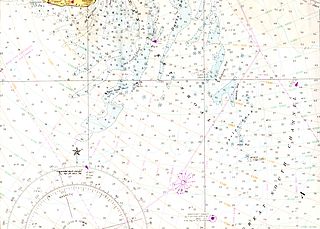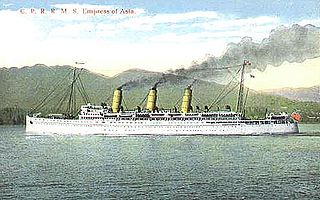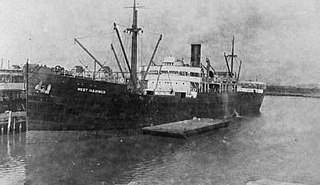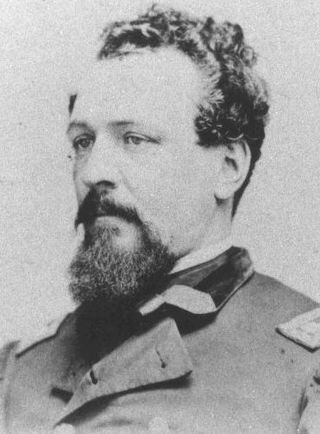Related Research Articles

The Laconia incident was a series of events surrounding the sinking of a British passenger ship in the Atlantic Ocean on 12 September 1942, during World War II, and a subsequent aerial attack on German and Italian submarines involved in rescue attempts. RMS Laconia, carrying 2,732 crew, passengers, soldiers, and prisoners of war, was torpedoed and sunk by U-156, a German U-boat, off the West African coast. Operating partly under the dictates of the old prize rules, the U-boat's commander, Korvettenkapitän Werner Hartenstein, immediately commenced rescue operations. U-156 broadcast her position on open radio channels to all Allied powers nearby, and was joined by the crews of several other U-boats in the vicinity.

PT 109 is a 1963 American Technicolor Panavision biographical war film depicting the actions of John F. Kennedy as an officer of the United States Navy in command of Motor Torpedo Boat PT-109 in the Pacific theater of World War II. The film was adapted by Vincent Flaherty and Howard Sheehan from the book PT 109: John F. Kennedy in World War II by Robert J. Donovan, and the screenplay was written by Richard L. Breen. Cliff Robertson stars as Kennedy, and the film features performances by Ty Hardin, James Gregory, Robert Culp and Grant Williams.

The second RMS Laconia was a Cunard ocean liner, built by Swan, Hunter & Wigham Richardson as a successor of the 1911–1917 Laconia. The new ship was launched on 9 April 1921, and made her maiden voyage on 25 May 1922 from Southampton to New York City. At the outbreak of the Second World War she was converted into an armed merchant cruiser, and later a troopship. Like her predecessor, sunk during the First World War, this Laconia was also destroyed by a German submarine. Some estimates of the death toll have suggested that over 1,658 people were killed when the Laconia sank. The U-boat commander Werner Hartenstein then staged a dramatic effort to rescue the passengers and the crew of Laconia, which involved additional German U-boats and became known as the Laconia incident.

Colonel Sir Reginald Hugh Dorman-Smith, GBE was an Anglo-Irish diplomat, soldier and politician in the British Empire.

Mary Therese McCarthy was an American novelist, critic and political activist, best known for her novel The Group, her marriage to critic Edmund Wilson, and her storied feud with playwright Lillian Hellman. McCarthy was the winner of the Horizon Prize in 1949 and was awarded two Guggenheim Fellowships, in 1949 and 1959. She was a member of the National Institute of Arts and Letters and the American Academy in Rome. In 1973, she delivered the Huizinga Lecture in Leiden, the Netherlands, under the title Can There Be a Gothic Literature? The same year she was elected a Fellow of the American Academy of Arts and Sciences. She won the National Medal for Literature and the Edward MacDowell Medal in 1984. McCarthy held honorary degrees from Bard, Bowdoin, Colby, Smith College, Syracuse University, the University of Maine at Orono, the University of Aberdeen, and the University of Hull.
William Edmund Butterworth III, better known by his pen name W. E. B. Griffin, was an American writer of military and detective fiction with 59 novels in seven series published under that name. Twenty-one of those books were co-written with his son, William E Butterworth IV. He also published under 11 other pseudonyms and three versions of his real name.
German submarine U-852 was a Type IXD2 U-boat built for Nazi Germany's Kriegsmarine during World War II. The submarine, which was a special long-range version of the Type IX, had four bow and two stern torpedo tubes and a Focke-Achgelis Fa 330 Bachstelze cable-towed lookout gyroglider. It was laid down in Bremen and completed in June 1943. She was commanded by Kapitänleutnant Heinz-Wilhelm Eck, who led her through her sea trials and onto her first war patrol on 18 January 1944.

The station named Nantucket or Nantucket Shoals was served by a number of lightvessels that marked the hazardous Nantucket Shoals south of Nantucket Island. The vessels, given numbers as their "name," had the station name painted on their hulls when assigned to the station. Several ships have been assigned to the Nantucket Shoals lightship station and have been called Nantucket. It was common for a lightship to be reassigned and then have the new station name painted on the hull. The Nantucket station was a significant US lightship station for transatlantic voyages. Established in 1854, the station marked the limits of the dangerous Nantucket Shoals. She was the last lightship seen by vessels departing the United States, as well as the first beacon seen on approach. The position was 40 miles (64 km) southeast of Nantucket Island, the farthest lightship in North America, and experienced clockwise rotary tidal currents.
German submarine U-405 was a Type VIIC U-boat of Nazi Germany's Kriegsmarine during World War II.

German submarine U-124 was a Type IXB U-boat of Nazi Germany's Kriegsmarine during World War II. She operated in the Atlantic as part of the 2nd U-boat flotilla, both west of Scotland and east of the eastern US coast. She was also present off northern South America.

RMS Empress of Asia was an ocean liner built in 1912–1913 by Fairfield Shipbuilding and Engineering at Govan on the Clyde in Scotland for Canadian Pacific Steamships.
Heinz-Wilhelm Eck was a German U-boat commander of the Second World War who was tried, convicted, condemned and executed after the war for ordering his crew to shoot the survivors of a Greek merchantman sunk by U-852.

SS Peleus was a steam merchant ship built in 1928 by William Gray & Company of West Hartlepool. Originally named Egglestone, she was acquired by E. E. Hadjilias, Syros and renamed after Pēleús, the mythical King of Aegina, and father of Achilles. Peleus was sold in 1933 to the Nereus Steam Navigation company. She had an uneventful career in peacetime, until the Second World War. She worked under charter for the British government during the war, and operated in the South Atlantic, until her loss in March 1944 when she was torpedoed and sunk by U-852.

The MV Kerlogue was an Irish ship attacked in World War II that has become the exemplar of neutral Irish ships during the war. The Kerlogue was a very small ship that was attacked by both sides and rescued people from both sides. She was almost sunk by a German mine and was strafed by the No. 307 Polish Night Fighter Squadron of the Royal Air Force. She rescued the Wild Rose of Liverpool and the survivors of the German destroyer Z27 and its escort, the survivors of which, in the latter case, were brought back to Ireland and interned until the end of hostilities.

SS West Maximus was a steel-hulled freighter built for the United States Shipping Board's emergency wartime construction program during World War I. Completed too late to see service in the war, West Maximus spent the interwar years in commercial service.
German submarine U-442 was a Type VIIC U-boat of Nazi Germany's Kriegsmarine during World War II.

James Gwyn was an officer in the Union Army during the American Civil War. He immigrated at a young age from Ireland in 1846, initially working as a storekeeper in Philadelphia and later as a clerk in New York City. At the onset of the war, in 1861, he enlisted and was commissioned as a captain with the 23rd Pennsylvania Volunteer Infantry. He assumed command of the 118th Pennsylvania Regiment in the course of the war. Gwyn led that regiment through many of its 39 recorded battles, including engagements at Seven Pines, Fredericksburg, Shepherdstown, Five Forks, Gettysburg, and Appomattox Court House.

Merchant seamen crewed the ships of the British Merchant Navy which kept the United Kingdom supplied with raw materials, arms, ammunition, fuel, food and all of the necessities of a nation at war throughout World War II — literally enabling the country to defend itself. In doing this, they sustained a considerably greater casualty rate than almost every other branch of the armed services and suffered great hardship. Seamen were aged from fourteen through to their late seventies.

Roselys was one of the nine Flower-class corvettes lent by the Royal Navy to the Free French Naval Forces. She served as a naval escort in World War II.
References
- ↑ "A Writer who, like Conrad, was nearly won by the sea". The New York Times . 6 August 1961. pp. BR5.
- ↑ "Obituary: Mr. Gwyn Griffin, Noted novelist". The Times . 13 October 1967. p. 10.
- ↑ "Milestones". Time . 20 October 1967. Retrieved 1 December 2011.
- ↑ "Gwyn Griffin, 42[sic], novelist, is dead". The New York Times. 14 October 1967. p. 27.
- ↑ Prescott, Orville (16 January 1963). "Books of the Times: Freedom observed". The New York Times. p. 6.
- ↑ Scott, Paul (17 February 1968). "Gwyn Griffin: a novelist looking for a country". The Times. p. 20.
- ↑ Olga S. Weber; Stephen J. Calvert, eds. (1980). Literary and Library Prizes (10 ed.). New York: R.R. Bowker Company. p. 307.
- ↑ Allen, Tonya (26 November 1999). "Review of An Operational Necessity at uboat.net" . Retrieved 1 December 2011.
This is a fictionalized account of the Peleus Affair, the only documented case in World War II in which a U-boat machine-gunned survivors in the water
- ↑ "World War II novel is selected for book club". The Dispatch (Lexington, N.C.). 10 July 1967. p. 2. Retrieved 1 December 2011.